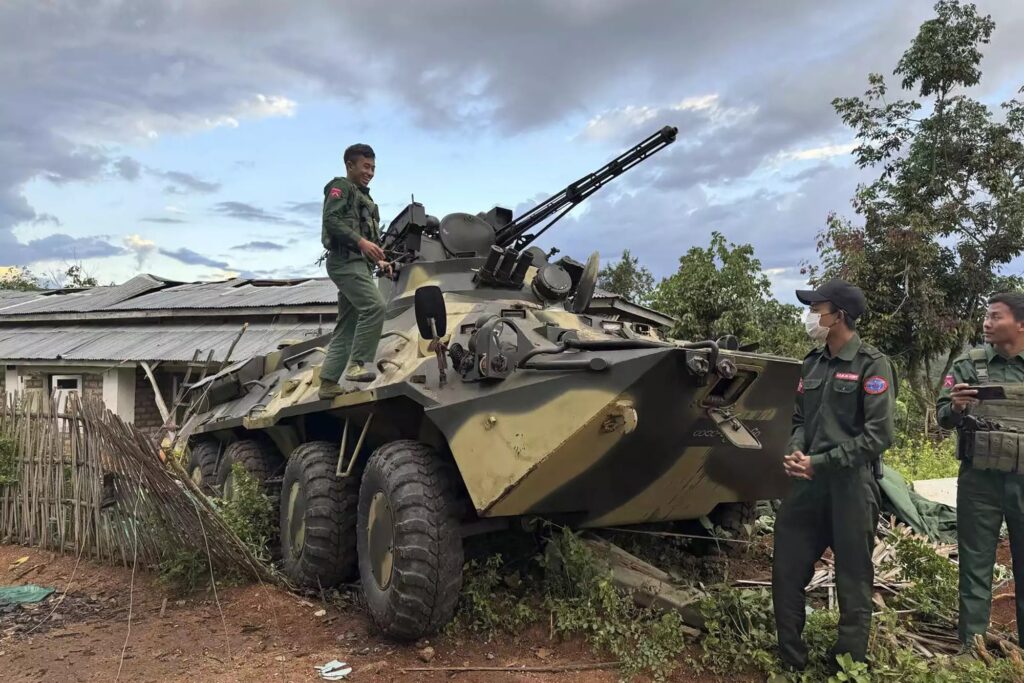I describe Burma as a ‘tragic nation’ because despite its strategic location and rich human and natural resources, it has been subjected to long cycles of violence and suffering at the hands of a predatory military, most recently in February 2021 when it put an end to the nation’s fledgling democratic experiment.
But recent developments may provide a window for the country to turn the corner. The stalemate that had developed since the coup between the regime’s armed forces (known as Tatmadaw) and opposition militias of various ethnic militias (known as Ethnic Armed Organisations or EAOs) as well as the People’s Defence Forces (PDFs) operating under the National Unity Government (NUG) seems to have been broken. Operation 1027 (October 27), a combined offensive launched by 3BHA (Three Brotherhood Alliance) comprising the Myanmar National Democratic Alliance Army (MNDAA), the Ta’ang National Liberation Army (TNLA) and the Arakan Army (AA), now effectively controls a large swath of the northern Shan state. This is an unprecedented humiliation for the Tatmadaw. It also significantly weakens the Tatmadaw’s control over the vital border areas with China.
Emulated by other militias, the offensive against the junta has extended to areas that directly border with India, especially Mizoram and Manipur — two of the four Indian states, that along with Nagaland and Arunachal Pradesh, share over 1,600 km land border with Myanmar, compared to the over 2,100 km of international border between Myanmar and China.
The direct spillover of the conflict onto India is still small; some 5,000 refugees have crossed the border to India since the October fighting adding to around 75,000 already in India then, including the Rohingyas. But the dramatic escalation of the civil war in a neighbouring nation significantly increases the stakes for New Delhi.
India’s approach to the Myanmar crisis since the February 2021 coup has been to engage with the junta led by Senior General Min Aung Hlaing. This has reportedly included providing arms that some estimates put at over $50 million and attending high-profile political events in Myanmar. For example, India’s defence secretary officially paid a visit past summer.
Three main considerations have driven this approach. One is border security, which requires cooperation with the Tatmadaw. India, the world’s largest democracy, has coldly calculated that cooperation with the Myanmar junta is a better way to keep the border secure than cooperating with the pro-democracy resistance. The importance of border stability has been increased by the ethnic tensions in Manipur, where the majority Meitei people have accused the Kuki community, who have ethnic ties with Myanmar’s Chin state, of sheltering their kinspeople from Myanmar which, they feel, will alter the demographic balance against them.
A second factor has been India’s broader strategic interest, which is not to let China gain more influence in a country that could increase its access to India’s vital maritime space in the Bay of Bengal and Indian Ocean.
A third reason is economic. Myanmar is part of India’s regional trade and infrastructure initiatives such as the Bay of Bengal Initiative for Multi-Sectoral Technical and Economic Cooperation (BIMSTEC) and Mekong-Ganga Cooperation (MGC).
But India has been pursuing its immediate self-interest while neglecting its long-term one. The cultivation of a regime that is widely despised by the people of Myanmar, including its majority Bamar people, harms India’s standing in the country. India could be the loser should the NUG emerge as winner in the conflict. It is time for New Delhi to politically engage the NUG while providing humanitarian aid through opposition channels to people caught in the conflict. On the run from opposition forces, including across the border to India, the Myanmar army has lost its capacity to cause serious mischief across the Indian border. New Delhi should not only focus on short-term sheltering and protection of refugees, but also planning for long-term reconstruction of the country. Working with the UN and ASEAN on these issues will be important, but as a direct neighbour, India cannot leave it entirely to the international community.
It is worth recalling that India provided crucial expertise for Burma’s first constitution. Respecting India’s emerging democratic model, Burma’s leader Aung San sought help from B N Rau, an adviser to the Constituent Assembly of India, to help with the drafting. Burma’s constitution was adopted on January 4, 1948, the same day it won independence from Britain. The similarities between the two constitutions included the fundamental rights and bicameral parliamentary democracy. Sadly, it did not fully emulate India’s federal democratic system, which is precisely what Myanmar’s opposition seeks to develop now. n
Acharya is the author of ‘Tragic Nation Burma: Why And How Democracy Failed’ and Distinguished Professor at American University in Washington DC.
Source: The Times Of India


